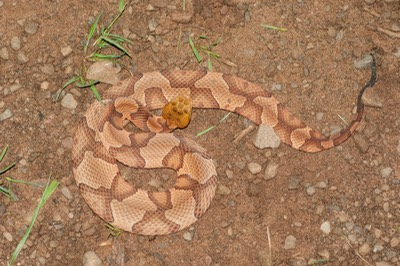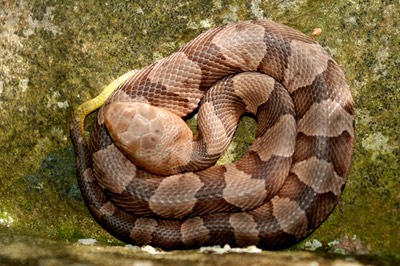
Copperhead Adult basking.
This is perhaps one of the prettiest snakes in Western Massachusetts. It’s too bad populations are restricted to just three or four locations and even where Copperheads do live they are often incredibly cryptic. Typically, these snakes remain motionless, often leaf basking with just a minimum of body exposed to sunlight. It’s easy to walk past one without noticing.
Virtually all “Copperhead” reports in our area are actually of Milksnakes, or Watersnakes. Even in Berkshire and Franklin counties, where Copperheads have never lived, mis-identifications abound. And, where they do exist in the southern Connecticut River Valley, Copperheads remain elusive. If you do see one, report it here.

Using radio-telemetry, I was lucky enough to follow a couple dozen individuals for several years. Females who were going to give birth later that summer never ventured far from their winter den. Males and juveniles traveled up to a mile (usually only half that distance) where they thermoregulated, searched for mates, hunted amphibians and small mammals, or shed their skin.
When pressed to defend themselves, Copperheads may lift their heads, curl into a striking position, and even vibrate their tails. Several people have been bitten in recent years due to either a legitimate mistake (reaching to remove brush) or from stupidity (people intentionally—and illegally— picking them up).

Top of head—No complex pattern here (see Milksnake)
Caudal Luring: One of the great evolutionary aspects of this species is their bright yellow-tipped tail at birth. The tail remains that color for about 2 years enabling young snakes to mimic a small caterpillar in leaf litter by wriggling it (how very cool is that). Frogs, small mammals, or perhaps birds may be attracted to this lure, thus providing Copperheads a slight advantage to procure their earliest meals. Neonates of the Copperheads’ nearest relative (the water moccasin of the deep southern US) also have this tail coloration, as do other species throughout the world.


